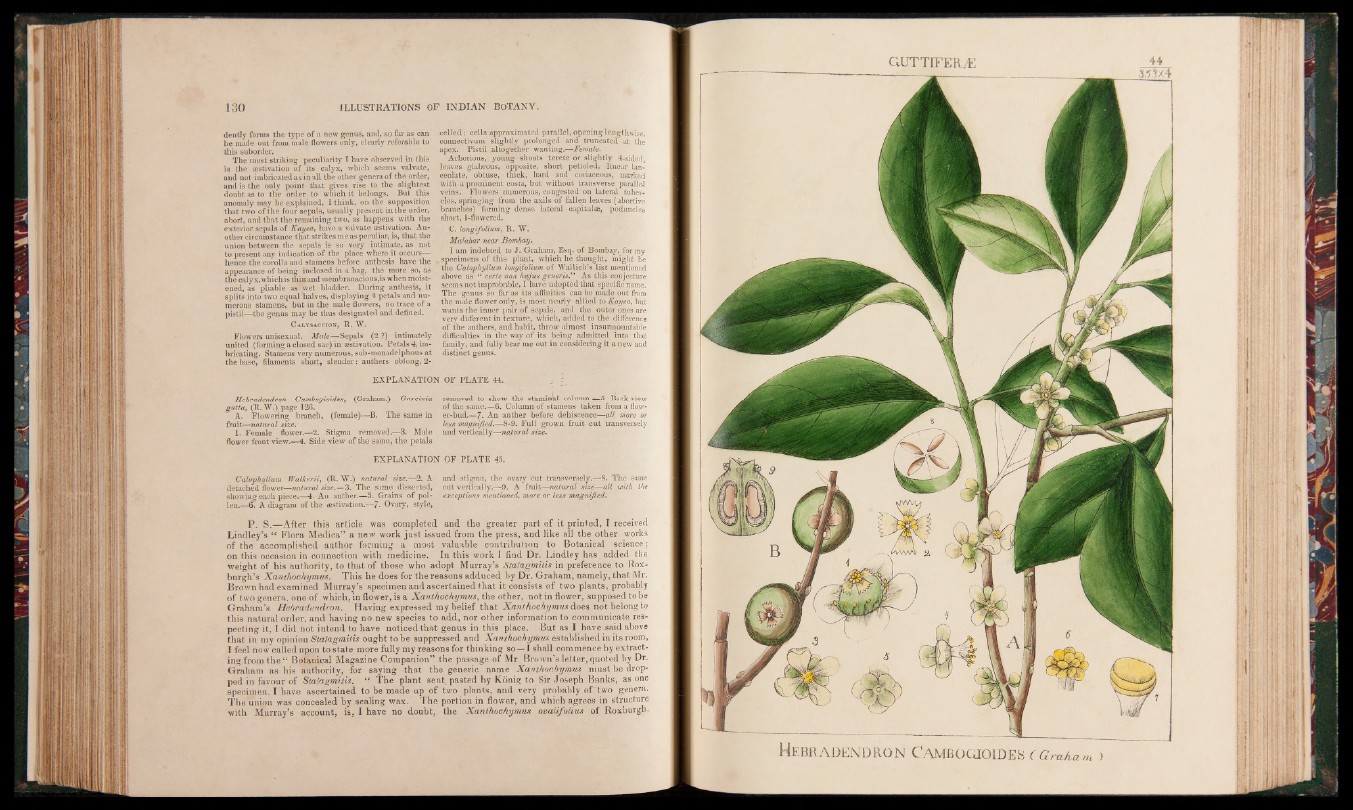
deafly forms the type of a new genus, and, so far as can
be made out from male flowers only, clearly referable to
this suborder.
The most striking peculiarity I have observed in this
is the aestivation of its calyx, which seems valvate,
and not imbricated as in all the other genera of the order,
and is the only point that gives rise to the slightest
doubt as to the order to which it belongs. But this
anomaly may be explained, I think, on the supposition
that two of the four sepals, usually present in the order,
abort, and that the remaining two, as happens with the
exterior sepals of Kayea, have a valvate aestivation. Another
circumstance that strikes me as peculiar, is, that the
union between the sepals is so very intimate, as not
to present any indication of the place where it occurs—
hence the corolla and stamens before anthesis have the
appearance of being inclosed in a bag, the more so, as
the calyx,which is thin and membranacious,is when moistened,
as pliable as wet bladder. During anthesis, it
splits into two equal halves, displaying 4 petals and numerous
stamens, but in the male flowers, no trace of a
pistil—the genus may be thus designated and defined.
Calysaccion, R. W.
Flowers unisexual. Male— Sepals (2 ?) intimately
united (forming a closed sac) in aestivation. Petals 4, imbricating.
Stamens very numerous, sub-monadelphous at
the base, filaments short, slender: anthers oblong, 2-
eelled: cells approximated parallel, opening lengthwise,
connectivum slightly prolonged and truncated at the
apex. Pistil altogether wanting.—Female.
Arborious, young shoots terete or slightly 4-sided,
leaves glabrous, opposite, short petiolea, linear lanceolate,
obtuse, thick, hard and coriaceous, marked
with-a prominent costa, but without transverse parallel
veins. Flowers numerous, congested on lateral tubercles,
springing from the axils of fallen leaves (abortive
branches) forming dense lateral 1 capitulae, peduncles
short, l-9owered.
C. longifolium, R. W.
Malabar near Bombay.
I am indebted to J. Graham, Esq. of Bombay, for my
1 specimens of this plant, which he thought, might be
the Calophyllum longifolium of Wallich’s list mentioned
above as “ certe non. hujus generis.” As this conjecture
seems not improbable, I have adopted that specific name.
The genus so far as its affinities can be made out from
the male flower only, is most nearly allied to Kayea, but
wants the inner pair of sepals, and the Outer ones are
very different in texture, which, added to the difference
of the anthers, and habit, throw almost insurmountable
difficulties in the way of its being admitted into that
family, and fully bear me out in considering it anew and
distinct genus'.
EXPLANATION OF PLATE 44.
removed to show the-staminal column.—5. Back view
of the same.—6. Column of stamens taken from a flower
bud.—7. An anther before dehiscence—all more or
less magnified.—8-9. Full grown fruit cut transversely
and vertically—natural size.
Hebradendrm Cambogioides, (Graham.) Garcinia
gutta, (R.W.), page 126.
A. Flowering branch, (female)—B. The same in
fruit—natural size.
1. Female flower.—2. Stigma removed.— 3. Male
flower front view.—4. Side view of the same, the petals
EXPLANATION OF PLATE 45.
Calophyllum Walkerii, (R. W.) natural size.—2. A and stigma, the ovary cut transversely.—-8. The same
detached flower—natural size.—3. The same'dissected, cut vertically.—9. A fruit—natural size■—all with the
showing each piece.— 4. An anther.—3. Grains of pol- exceptions mentioned, more or dess magnified.
len.—-6. A diagram of the aestivation.—7- Ovary, style,
P. S.—After this article was completed and the greater part of it printed, I received
Lindley’s “ Flora Medica” a new work just issued from the press, and like all the other works
of the accomplished author forming a most valuable contribution to Botanical science;
on this occasion in connection with medicine. In this work I find Dr. Lindley has added the
weight of his authority, to that of those who adopt Murray’s Stalagmitis in preference to Roxburgh’s
Xanthochymus. This he does for the reasons adduced by Dr. Graham, namely, that Mr.
Brown had examined Murray’s specimen and ascertained that it consists of two plants, probably
of two genera, one of which, in flower, is a Xanthochymus, the other, not in flower, supposed to be
Graham’s Hebradendron. Having expressed my belief that Xanthochymus does not belong to
this natural order, and having no new species to add, nor other information to communicate respecting
it, I did not intend to have noticed that genus in this place. But as I have said above
that in my opinion Stalagmitis ought to be suppressed and Xanthochymus established in its room,
I feel now called upon to state more fully my reasons for thinking so—I shall commence by extracting
from the “ Botanical Magazine Companion” the passage of Mr Brown’s letter,quoted by Dr.
Graham as his authority, for saying that the generic name Xanthochymus must be dropped
in favour of Stalagmitis. “ The plant sent, pasted by Konig to Sir Joseph Banks, as one
specimen. I have ascertained to be made up of two plants, and very probably of two genera.
The union was concealed by sealing wax. The portion in flower, and which agrees in structure
with Murray’s account, is, I have no doubt, the Xanthochymus ovalifolius of Roxburgh,
GUTTIFERÆ
Hebr a d en d r o n Cambogioides c G r a h a m >